When you buy through our links, we may earn a commission. Products or services may be offered by an affiliated entity. Learn more.
Best Mattress for Back Pain
Tested and Ranked by Sleep Experts
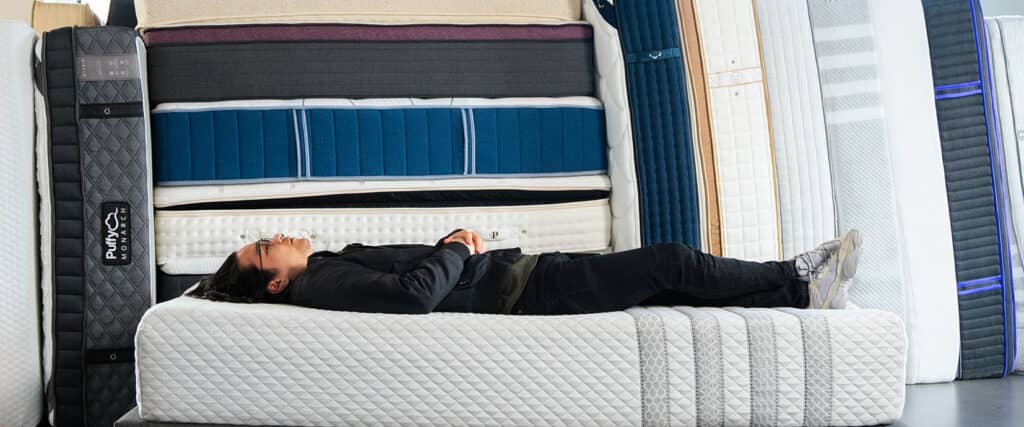
You may have heard that a firm mattress is good for back pain, but that’s only sometimes true. The right mattress for your back depends on you. Someone with a larger build may need a firmer bed, while someone smaller might find that same bed too stiff since they don’t sink in as much.
What really matters is that your mattress provides that just right amount of support to keep your spine aligned while you sleep. If your bed’s too soft or too firm, your body won’t be able to relax and you’ll wake up stiff, sore, and tired. We’ve put together this list of top mattresses for back pain to help you find your perfect fit. Our team has run each of these beds through our testing gauntlet and we’ve personally vetted them in our homes.
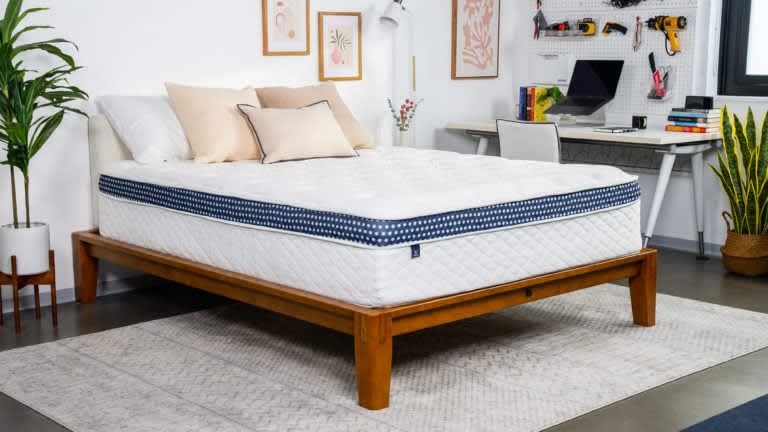

The WinkBed
For back pain, we recommend beds that carefully balance support and pressure relief. Our testers found the WinkBed performed well in these categories thanks to its combination of adaptive foam and sturdy coils.
The Best Mattresses For Upper and Lower Back Pain
- Best Overall Mattress – WinkBed
- Best Value Mattress – DreamCloud Mattress
- Best Mattress for Lumbar Support – Saatva Classic
- Best Mattress for Side Sleepers – Helix Midnight Luxe
- Most Comfortable Mattress – Leesa Sapira Hybrid
- Best Mattress for Spinal Alignment – Nolah Evolution 15
- Best Mattress for Pressure Relief – Brooklyn Bedding Signature Hybrid
- Best Mattress for Couples – Bear Elite Hybrid
- Best Firm Mattress – Plank Firm Luxe
- Best Mattress for Combination Sleepers – Layla Hybrid
In-Depth Reviews
Best Overall Mattress for Back Pain
WinkBed
Get $300 off all mattresses at Winkbeds
$1,499 at WinkBeds



“One of the standout features of the WinkBed is its truly balanced feel, from light contouring in the quilted foam surface to firm pushback from the zoned coil system. Three of our field testers have been sleeping on WinkBeds for 2 years and they all report excellent support and reduced back pain.” – Daniel Noyed, Senior Product Editor
-
Pros
-
Four firmness options cater to a wide array of sleepers
-
Zoned pocketed coils in support core
-
Foam Euro-top promotes cushioning and pressure relief
-
-
Cons
-
Foam may produce some initial off-gassing
-
Some may find coils too bouncy
-
Mattress Type
Innerspring
Firmness Options
Medium Soft (4), Medium Firm (6), Firm (7), Firm (8)
Price Range
$1,149 – $2,049
Trial Period
120 nights (30 night requirement)
Customer Reviews
Randall D.
“After the 3rd day, I knew I made the right decision. This is my second WinkBed that I have purchased. The first one I put on the guest bed and every guest — and I have a lot of overnight guest — absolutely loved it, and some even went home and bought one.”
Micah T.
“Overall comfortable but too firm for us. We swapped for the softer WinkBed and are sleeping great now!”
Kimberly K.
“My back pain is gone, however we had to purchase an additional topper because the “luxury” wasn’t as soft as we’d hoped. It caused pain in my hips and shoulders due to being a side sleeper.”
Product Details
If you carry extra weight around the midsection, a mattress with zoned layers can be a solid investment. The WinkBed is a luxury hybrid available in four firmness levels to give you plenty of options for finding that sweet spot between comfort and support.
How It Performed
Testers on our team weighing less than 130 pounds found the medium soft (4) WinkBed most comfortable, particularly the side sleepers. The medium firm (6) design earned high marks from our testers weighing 130 to 230 pounds across all three position groups. Our back and stomach sleepers weighing 130 pounds or more also found the firm (7) design comfortable, and those over 230 pounds were impressed by the robust support of the WinkBed Plus (8).
Thanks to the zoned coils, the WinkBed scored high marks during our tests for edge support and ease of movement. Most of us could scoot across the surface of the mattress without feeling stuck — a common problem when support is lacking — and the perimeter felt stable as we mimicked movements associated with getting in and out of bed, tying our shoes, and changing positions near the edges.
What It’s Made of
The medium soft, medium firm, and firm WinkBeds feature adaptive polyfoam quilted into the surface, followed by a layer of denser foam to cushion and reinforce your body. WinkBed Plus models swap out the second foam layer for zoned latex, which is very bouncy and shouldn’t buckle too much beneath your body — even if you weigh more than 230 pounds.
All WinkBeds feature zoned pocketed coils in their support cores. Thicker coils line the perimeter to protect the edges from deep sinkage, and also rest beneath your chest and hips to push back against your extra weight in these areas. A cover made of eucalyptus-derived Tencel fabric encases the entire mattress.
Your WinkBed purchase comes with a 120-night trial. As part of WinkBeds’ return policy, you may exchange your initial mattress for a softer or firmer model if you aren’t satisfied with how it feels. The replacement mattress comes with its own 60-night trial. All WinkBed mattresses are additionally backed by lifetime warranties, and shipping is free for shoppers in the contiguous U.S.
Best Value Mattress for Back Pain
DreamCloud Mattress
Up to 50% off at DreamCloud
$665 at DreamCloud



“After a year of sleeping on the DreamCloud, our product field tester reported a significant improvement in back pain and less tossing and turning. The plush foam layers ease pressure off sensitive joints while the robust coil system keeps your lower back plenty supported.” – Lauren Fountain, Senior Product Editor
-
Pros
-
Medium firm feel with a balance of contouring and support
-
Breathable cashmere blend cover
-
Lifetime warranty and 365-night sleep trial
-
-
Cons
-
Foam layers can emit strong initial off-gassing
-
Stomach sleepers over 230 pounds may prefer a firmer mattress
-
Mattress Type
Hybrid
Firmness Options
Medium Firm (6)
Price Range
$499 – $999
Trial Period
365 nights (30-night requirement)
Customer Reviews
Lori S.
“I wasn’t sure how the mattress was going to affect my injured neck and sensitive back. I’m very pleased to say that I could not be more comfortable.”
Steven A.
“The mattress itself is high quality and super easy to set up. It didn’t take long to take its full regular shape once unboxed and opened up. Sadly, it’s just not firm enough for me.”
Thomas G.
“We are enjoying our new mattress. The one drawback for me is the edge support.”
Product Details
The DreamCloud Mattress is a luxury hybrid with adaptive comfort layers with a strong support system. A medium firm (6) feel ensures plenty of cushioning for your shoulders, lower back, and hips, but we also found the bed’s thick pocketed coils maintain an even surface and reduce sinkage around the midsection — a common source of aches and pains. Approachable pricing and a generous sleep trial sweeten the deal even further if you’re shopping on a budget.
How It Performed
While the DreamCloud’s strongest ratings came from our side sleepers between 130 and 230 pounds, the mattress was well received by most of our testers across different body types and sleep positions. Ample cushioning prevented our side sleepers from feeling sharp pressure points in their shoulders and hips, which often occur for people who use this position. Back sleepers on our team didn’t sink too much despite the thick foam layers.
Temperature control was another high point for the DreamCloud during our tests. The above-average cooling comes from both the moisture-wicking cashmere blend cover and steady air circulation through the coil system. Thanks to the thick foam layers, the mattress also performed better than many competing hybrids in testing categories like motion isolation and pressure relief.
What It’s Made of
The DreamCloud begins with polyfoam quilted into the cover, followed by memory foam and polyfoam comfort layers. These materials make the mattress invitingly plush when you get into bed, but each layer is progressively denser and you shouldn’t sink too deeply as your body settles. The support core contains pocketed coils over a high-density foam base. A cover made from a breathable cashmere blend encases the mattress.
Shipping is free if you reside in the contiguous U.S. Each order comes with a sleep trial that spans an entire year, giving you plenty of time to test the mattress and decide whether it’s right for you. Should you decide to keep the bed, you’ll also receive a lifetime warranty against structural defects.
“The Saatva Classic has a unique coil-on-coil design that provides exceptional responsiveness, with a zoned design that really boosts support under the heavier parts of my body. The thing I appreciate most is the memory foam pad under the lumbar region. This gave me extra cushioning to help with my lower back pain.” – Mark Horiuchi, Lead Product Tester
-
Pros
-
Choice of two height profiles and three firmness levels
-
Coil-on-Coil construction with extra pillow-top support
-
Free White Glove delivery
-
-
Cons
-
Coils may feel too bouncy for some sleepers
-
$99 restocking fee on all mattress returns
-
Mattress Type
Innerspring
Firmness Options
Soft (3), Medium Firm (6), Firm (8)
Price Range
$995 – $2,710
Trial Period
365 Nights ($99 Return Fee)
Customer Reviews
Chang L.
“I’m a back and occasional side sleeper, and absolutely love this bed. My husband is a stomach sleeper and would prefer his bed to be a tiny bit firmer.”
Nancy
“If you like a firm mattress, Saatva Classic may be for you. If, like me, you are used to a plush pillow top mattress and you want a soft plush mattress, you should keep looking. This is a nice mattress, but it is NOT soft.”
Sunny B.
“I love my new Saatva classic full, luxury firm matress. I went with the 14.5″ and I’m really happy with it. I didn’t give 5 stars because it is softer than I expected from a ‘firm’ mattress, but maybe it’s just a matter of getting used to it.”
Product Details
Saatva’s mattress line has expanded over the past decade, but the luxurious Saatva Classic is still a fan favorite. One of the first mainstream innersprings to incorporate a coil-on-coil design, the Classic is available in three firmness levels and two profiles to accommodate a wide swath of sleepers.
How It Performed
The soft (3) design provides deep contouring, and was a hit among our side sleepers weighing up to 230 pounds. At the other end of the spectrum, the firm (8) model cushions very little and feels exceptionally supportive. Our back and stomach sleepers weighing at least 130 pounds preferred this model. If you’re looking for a balance of conforming and stability, you should consider the medium firm (6) design — this one earned favorable ratings from our testers across different weight and position groups.
All three Saatva Classics scored high ratings for edge support and ease of movement. The dual-coil construction creates a nice bounce on the surface, so you shouldn’t sink or feel stuck when getting in and out of bed. Reinforced perimeter coils also push back against your weight when you’re sitting or sleeping along the edges. Both coil layers circulate air, so the mattress also nabbed solid ratings for temperature control.
What It’s Made of
The Saatva Classic’s Euro-top cover is cushioned with foam and plush fibers. A memory foam pad located beneath the lower back is intended to support your lumbar region and minimize pain, while transitional minicoils offer extra reinforcement without creating too much motion transfer.
The support core contains sturdy hourglass coils made of recycled steel. You can opt for an 11.5-inch mattress with 4-inch support coils, or a 14.5-inch model with 7-inch coils. We recommend the latter if you need extra support to sleep comfortably. A cover made of breathable organic cotton helps the surface stay cool.
The Classic’s sticker price is reasonable compared to other high-end innersprings and hybrids. Saatva is one of the only online mattress brands to offer free White Glove delivery to all customers in the contiguous U.S. This service includes full setup in a room of your choice and removal of your old mattress and box spring upon request. All purchases are backed by year-long sleep trials and lifetime warranties.
Best Mattress for Side Sleepers with Back Pain
Helix Midnight Luxe
20% off + 2 free pillows at Helix
$1,899 at Helix

“The Helix Midnight Luxe was originally created with side sleepers in mind, and our hands-on tests show this medium firm hybrid works as intended. Deep foam layers over zoned coils create a soothing balance of cushioning, support, and responsiveness to reduce pressure in the shoulders and hips.” – Jeremy Klein, Senior Product Testing Manager
-
Pros
-
Adaptive foam comfort layers cradle the body and alleviate sore spots
-
Zoned coils provide extra support for the midsection
-
Both cover options excel at cooling
-
-
Cons
-
Foam emits a strong off-gassing odor for the first few nights
-
Back and stomach sleepers over 230 pounds may not receive adequate support
-
Mattress Type
Hybrid
Firmness Options
Medium Firm (6)
Price Range
$1,099 – $2,299
Trial Period
100 nights (30-night requirement)
Customer Reviews
Julia R.
“I have better sleeps now because of purchasing this mattress. I’m mostly a side and back sleeper but am a lightweight person and this mattress felt great and I sleep the whole night through now.”
Abhay C.
“I haven’t been able to sleep properly, too soft for my liking. I have been waking up everyday with a back ache.”
Mandy W.
“Very comfortable and nicely made mattress. I’m a warm sleeper, and this mattress is very warm at night…so be aware if that’s something that bothers you.”
Many mattresses are suitable for side sleepers, but the Helix Midnight Luxe was specifically designed to accommodate this sleep position. While the target audience weighs 130 to 230 pounds, our testing team found the mattress is comfortable for most sleepers across different weight groups.
How It Performed
Our hands-on tests of the Midnight Luxe revealed the mattress is ideal for side sleepers between 130 and 230 pounds and back sleepers under 130 pounds. That said, the mattress earned favorable ratings from most of our team. The balanced medium firm (6) feel ensures ample cushioning for side sleepers, as well as sturdy support for back and stomach sleepers — though people who use the latter two positions and weigh more than 230 pounds may find the Midnight Luxe too soft.
During our temperature control tests, we found that the Midnight Luxe sleeps fairly cool and doesn’t retain much heat despite the deep foam layers. The Tencel cover gets much of the credit, as this material is known for breathability and moisture-wicking properties. People who are exceptionally warm sleepers should consider the GlacioTex cover upgrade — this fabric is engineered to dissipate heat on contact and feel cool at all times. Other testing areas where the Midnight Luxe performed well include edge support, pressure relief, and motion isolation.
What It’s Made of
The Midnight Luxe’s Euro-top surface is cushioned with three foam layers, beginning with two layers of memory foam. You’ll notice a light bounce when you get into bed — this comes from the coils — but as your body settles, the foam molds to your figure for a cloud-like cradling effect. Transitional polyfoam provides additional cushioning, but this layer is denser to create some pushback against your weight.
The support core contains pocketed coils over dense base foam. Thicker springs rest below your torso and hips to deliver extra reinforcement for heavier areas of your body. The perimeter coils are also lower-gauge to prevent deep sinkage when you lie or sit along the edges. Standard Midnight Luxe models include a moisture-wicking Tencel cover. For an added charge, you can upgrade to a cover made of GlacioTex phase change material.
The Midnight Luxe is reasonably priced for a luxury hybrid and standard shipping is free to all 50 states. You’ll also receive two complimentary pillows with your order. Helix’s sleep trial runs for 100 nights. If you decide to keep the mattress after the trial ends, Helix further backs your purchase with a 15-year warranty.
Most Comfortable Mattress for Back Pain
Leesa Sapira Hybrid
20% off mattresses + free pillows at Leesa
$1,599 at Leesa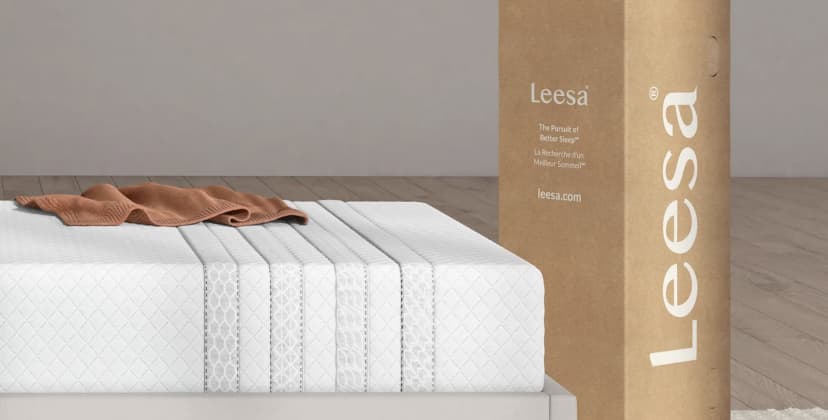
“Our team appreciated the Leesa Sapira Hybrid’s balanced feel, which made it a hit among testers with back pain. The foam layers offer great cushioning along the spine without causing excessive sinkage.” – Jackson Lindeke, Executive Director
-
Pros
-
Mixed-foam comfort system offers contouring without excessive sinkage
-
Aerated layers encourage airflow to keep sleepers cool
-
Reinforced perimeter enhances edge support
-
-
Cons
-
Coils produce noticeable motion transfer
-
Stomach sleepers over 230 pounds may prefer a more supportive bed
-
Mattress Type
Hybrid
Firmness Options
Medium Firm (6)
Price Range
$1,349 – $2,299
Trial Period
100 nights (30 night requirement)
Customer Reviews
William M.
“This mattress is firm, but not too firm and soft, but not too soft. It’s comfortable.”
Kathryn D.
“The mattress is very springy – as a king mattress, you can feel every movement of the other person on the bed. Although we bought this mattress to be able to sleep together, I am sleeping on another bed because this mattress makes it impossible to both sleep in the same bed.”
Elizabeth
“We were initially worried it would be too soft but that hasn’t been a problem. The issue seems to be that it gets really warm ensconced in there overnight, such that I am tossing off coverings in the wee hours.”
Hybrids are often popular among sleepers who have persistent back pain. This is mainly due to their balanced design, contouring comfort layers, and supportive coils. The Leesa Sapira Hybrid elaborates on this design with a mixed foam comfort system and a medium firm (6) feel to ensure the mattress contours deeply and relieves pressure without sinking too deeply beneath your weight.
How It Performed
The Sapira Hybrid’s foam comfort system and medium firm feel best suited side sleepers on our team, specifically those who weigh at least 130 pounds. The foam layers deeply contoured to their shoulders and hips, areas where pressure tends to build for those who use this position. Our back and stomach sleepers weighing under 130 pounds also found the mattress comfortable.
The mattress had balanced performance across our testing categories, but particularly excelled in our tests for ease of movement and temperature neutrality. Mattresses with foam layers tend to trap heat, but the aerated polyfoam layer and breathable coil support core help keep you cool. We also recommend the Sapira Hybrid for couples, thanks to a bouncy feel that many will appreciate for sex. Most people should be able to move across the mattress surface with little restriction.
What It’s Made of
The Sapira Hybrid begins with a layer of polyfoam engineered to be more responsive while cushioning along the spine. This layer is aerated with small holes to increase airflow near the surface. Underneath is a layer of memory foam that adapts to the body to relieve pressure points along the spine. A polyfoam transitional layer makes sure your weight is evenly distributed.
Pocketed coils make up the support core. These coils have a lower gauge, offering ample pushback to prevent midsection sagging. The coil system is reinforced along the perimeter, so you don’t sink when laying or sitting along the edges. The coils rest on a polyfoam base layer for stability, and a knit polyester cover encases the mattress.
Leesa ships for free to customers living in all 50 states. The company also offers a 100-night sleep trial, during which you can test the Sapira Hybrid and return it anytime after the 30-night break-in period. If you decide to keep the mattress, it is backed by a 10-year warranty.
Best Mattress for Spinal Alignment
Nolah Evolution 15
35% off mattresses + 2 free pillows at Nolah
$1,624 at Nolah Sleep

“The Nolah Evolution 15 has a plush Euro-top that conforms closely to your body, with coils that are zoned to offer extra support where your body really needs it. My neck and spine felt perfectly aligned when I tested this mattress in the lab.” – Logan Foley, Editorial Director
-
Pros
-
Three firmness levels suit sleepers across weight and sleeping position groups
-
Polyfoam-quilted Euro-top contours to the body to alleviate pressure buildup in the joints
-
Zoned pocketed coils provide targeted support to the midsection and the mattress perimeter
-
-
Cons
-
Foam layers retain some heat
-
Coils produce some motion transfer
-
Mattress Type
Hybrid
Firmness Options
Medium (5), Medium Firm (6), Firm (8)
Price Range
$1,004 – $2,143
Trial Period
120 nights (30-night requirement)
Customer Reviews
Phyllis B.
“I don’t wake up with shoulder or neck pain like I did with my previous mattress (I am a side sleeper). I also don’t feel it when my husband gets in and out of bed. Recommend it!”
Christopher R.
“It is one of those Goldilocks situations where the bed is not too hard, not too soft, but just right. My wife prefers more support while I prefer more comfort, but the bed works well for the both of us.”
Joseph B.
“I very much love my new Nolah mattress. It is firm but not too firm. Just the way I like it. I especially like the firm edges.”
Product Details
A mattress that promotes spinal alignment can be invaluable if you wake up with pain or sore spots in your shoulders, back, and hips. The Nolah Evolution 15 contains four foam layers to cushion and contour to the body, evenly distributing your weight to improve your alignment, while a zoned coil system pushes back against extra weight from your midsection and reduces perimeter sinkage.
How It Performed
The medium (5) Evolution 15 conforms closely, and we found it best suited to side sleepers weighing up to 230 pounds. Our back and stomach sleepers under 130 pounds felt comfortable on this design, but also gave higher marks to the medium firm (6) feel. For the firm (8) model, our testers weighing more than 230 pounds received adequate support and didn’t sink too much.
The Evolution 15 uses open-cell foam layers engineered to keep the surface cool. Our temperature control tests showed very little heat buildup. The zoned coils also allowed the mattress to perform well during our tests for edge support and ease of movement. The two firmest models were particularly strong in these categories.
What It’s Made of
Four foam layers encased in a Euro-top cover make up the Evolution 15’s comfort system. These layers are progressively denser from top to bottom, so you’ll feel plush cushioning when you get into bed but the underlying foams keep your body on an even plane.
The zoned support core features thicker coils along the perimeter and beneath your chest and hips. This helps you move across the surface without feeling stuck, and also helps ensure you’ll feel extra pushback around heavier areas of the body. The cover is made of proprietary ArcticTex fabric that feels cool to the touch.
Nolah offers free ground shipping within the contiguous U.S. Each Evolution 15 purchase includes a 120-night sleep trial, but you can opt out of the trial period and reduce the sticker price by as much as $150. A lifetime warranty backs each mattress. For additional protection, you can purchase an accident protection plan that covers stains and other types of physical damage not covered in your standard warranty.
Best Pressure Relieving Mattress for Back Pain
Brooklyn Bedding Signature Hybrid
Save 25% sitewide at Brooklyn Bedding
$999 at Brooklyn Bedding


“The Brooklyn Bedding Signature Hybrid offers the best of both worlds when it comes to support and contouring. I enjoyed the gentle cradling from the polyfoam layers, but the coils kept my body more ‘on top’ of the bed than ‘in’ the bed.” – Tom Ryan, Head of Product Testing
-
Pros
-
Three firmness options
-
Optional cooling cover
-
Foam layers excel at pressure relief
-
-
Cons
-
Hot sleepers may overheat without the cooling cover
-
$99 fee for all returns
-
Mattress Type
Hybrid
Firmness Options
Medium Soft (4), Medium Firm (6), Firm (8)
Price Range
$499 – $1,199
Trial Period
120 nights (30-night requirement)
Customer Reviews
Greg C.
“Very comfortable and soft. No longer have hip or back pain. The only issue we have is that the sheets tend to slide loose overnight.”
Cindi W.
“The bed is comfortable, but I think I should have ordered the firm. I feel like the bed is already sagging in the middle but I can’t tell if it’s the bed, or that I need a firmer mattress.”
Charolette Y.
“So far, we are very satisfied with our purchase. From the ordering to delivery and the mattress itself, all went well. We tried to be frugal and looked for quality. We feel we reached that goal.”
Product Details
The Brooklyn Bedding Signature Hybrid combines adaptive foam and supportive coils for an overall balanced feel. With three firmness options to choose from, you can pick the model that best suits your sleep position and personal sleep preferences.
How It Performed
The mattress is available in medium soft (4), medium firm (6), and firm (8) designs. Our testers found the foam comfort layers offered very good pressure relief regardless of the firmness level. The medium soft option was an excellent fit for side sleepers up to 230 pounds and back sleepers up to 130 pounds, since these folks need deep cushioning for the shoulders, hips, and spine. Back and side sleepers between 130 and 230 pounds preferred the medium firm option, while the firm model felt most comfortable to stomach sleepers of at least 130 pounds and back sleepers over 230 pounds.
The coils give the firmer Signature Hybrids a responsive feel. You should consider one of these models if you’re looking for a mattress that won’t sink too much when you move across the surface. The softer models performed well during our motion isolation tests. This can benefit anyone who shares their bed with a restless sleeper.
What It’s Made of
All three firmness options begin with a quilted surface for a plush feel, followed by two polyfoam layers to enhance cushioning. Layers vary in thickness and firmness depending on the model you choose. The support core is composed of pocketed coils that generate sturdy support, with strong coils around the perimeter to boost edge support. Airflow through the coils helps keep the bed cool, but for an additional fee you can also add a pillow-top made with a specialized GlacioTex cooling fiber.
Brooklyn Bedding offers a 120-night sleep trial and 10-year warranty. Shipping is free to addresses in the contiguous U.S.
Best Mattress for Couples with Back Pain
Bear Elite Hybrid
35% off + 2 free pillows at Bear. Code: SF36
$1,499 at Bear

“The Bear Elite Hybrid combines memory foam and polyfoam layers to produce gentle contouring, so I recommend it for sleepers who need some cradling but also require a sturdy base. The reinforced edges are a welcome touch, especially for co-sleepers who use every inch of their bed surface.” – Brad Nehring, Senior Product Manager
-
Pros
-
Three firmness options
-
Cooling fabric and steady airflow through the coils help maintain temperature neutrality
-
Memory foam provides strong pressure relief
-
-
Cons
-
Softer models may inhibit some movement across surface
-
Foam may produce initial off-gassing
-
Mattress Type
Hybrid
Firmness Options
Medium (5), Medium Firm (6), Firm (8)
Price Range
$1,231 – $2,548
Trial Period
120 nights (30-night break-in period)
Customer Reviews
Walter F.
“I weigh 220 lbs, my wife weighs 130 lbs… we both love the mattress. The hybrid gives me the support I need, while it also gives my wife the comfort she needs. It’s the best parts of a coil mattress and a memory foam mattress.”
Keith B.
“I sleep with my wife and bad edge support is a non-starter for her. On the Bear Elite Hybrid she sleeps right near the edge with no issues. Edge support is very good.”
Sheila H.
“I think for the money, the Bear Elite Hybrid felt higher-quality compared to other online mattresses, regardless of price. This is built and feels more like a quality traditional mattress compared to many others.”
Product Details
Most of our testers found the Bear Elite Hybrid comfortable thanks to adaptive foam layers that reduce pressure, a supportive coil system, and cooling components that cut down on heat buildup. The mattress is also available in three firmness levels — and if you opt for a split king size, Bear lets you choose a different firmness for each side of the bed.
How It Performed
The medium (5) Elite Hybrid design was most popular among our side and back sleepers weighing up to 230 pounds. This model contours closely to the body for optimal weight distribution, even alignment, and pressure relief along the spine. If you’re seeking a slightly more supportive build, you should consider the medium firm (6) — this one earned rave reviews from our side sleepers between 130 and 230 pounds and sleepers up to 230 pounds. The firm (8) feel provides light cushioning and robust support, making it most comfortable for testers over 230 pounds.
The Elite Hybrid’s zoned transitional layer maintained an even surface for our bodies and prevented uncomfortable sinkage below the chest, stomach, and hips. Our thermal sensors didn’t detect much heat buildup during temperature control tests, and we noticed a good deal of pushback along the perimeter when testing the mattress for edge support.
What It’s Made of
All versions of the Elite Hybrid begin with a memory foam comfort layer, followed by transitional polyfoam. The memory foam is infused with copper to help keep the surface nice and cool. The coils also generate steady circulation throughout the interior, and a cover made of Celliant-blend fabric prevents the mattress from retaining too much heat. The coils are zoned to be thicker and sturdier along the edges, allowing you to sleep along the perimeter and get in and out of bed without sinking.
All customers in the contiguous U.S. receive free ground shipping. The Elite Hybrid is backed by a 120-night sleep trial and a lifetime warranty against structural defects. You may purchase additional protection that covers stains and other types of physical damage for up to 10 years.
Best Firm Mattress for Back Pain
Plank Firm Luxe
Save 25% sitewide at Plank
$1,149 at Brooklyn Bedding

“The Plank Firm Luxe provides an incredible amount of support on both surfaces of the flippable design, with a strong coil system in the middle. If the firm side isn’t supportive enough, you can flip it over to the extra firm side and really kick it up a notch. If you’re over 230 pounds or just in the market for exceptional firmness, this bed is worth a look.” – Jackson Lindeke, Executive Director
-
Pros
-
Flippable design features firm and extra-firm surfaces
-
Optional phase change panel provides exceptional cooling
-
Excellent edge support
-
-
Cons
-
Side sleepers with painful pressure points may need a softer bed
-
Some may find the coils too bouncy
-
Mattress Type
Hybrid
Firmness Options
Firm (7), Extra Firm (9)
Price Range
$693 – $1,299
Trial Period
120 nights (30-night requirement)
Customer Reviews
Robert J.
“This puppy is really HARD. I know why you named it Plank.”
Bryan M.
“Improved my back pain right away. Extra firm side was a bit too much, so really appreciated the option to flip the mattress to the slightly more forgiving side.”
Ping Z.
“I’m using the extra firm side with a mattress topper. I often had back pain due to my lower back problem. Sleeping on this mattress, I no longer feel pain in the morning.”
Product Details
Many mattress brands advertise their beds as “soft” or “plush,” but the fact is some people benefit from less cushioning and a firmer feel. These sleepers are great candidates for the reversible Plank Firm Luxe, which features a firm (7) feel on one side and an extra firm (9) feel on the other. The latter is one of the firmest surfaces we’ve tested in our lab, and should be suitable for anyone who has found other foam hybrids too soft.
How It Performed
The Plank Firm Luxe earned its most favorable ratings from back and stomach sleepers weighing at least 130 pounds. The majority of our testers preferred the firm side, but a few of us weighing more than 230 pounds appreciated the extra firm surface’s light contouring and robust support.
As is often the case with firmer mattresses, the Plank Firm Luxe performed exceptionally well during our edge support and ease of movement tests. The mattress also sleeps quite cool thanks to consistent airflow through the coil layer. You can opt for a phase change panel on each side if you tend to overheat in bed or sweat in your sleep.
What It’s Made of
The Plank Firm Luxe’s firm side features a layer of quilting material, followed by latex-like TitanFlex foam and high-density polyfoam. These materials provide a small measure of cushioning without sacrificing firmness or support. The extra firm side does not contain any TitanFlex and the polyfoam layer is thinner, so this surface conforms very little. A shared support core of pocketed coils rests between the comfort systems.
In addition to the standard model, you can order phase change panels to be sewn into both sleep surfaces. Phase change material is engineered to dissipate body heat on contact and maintain a cool, comfortable surface at all times.
The Plank Firm Luxe is reasonably priced compared to other hybrid models and ground shipping is free within the contiguous U.S. You’ll receive a 120-night sleep trial with your purchase, and a 10-year warranty against structural defects if you decide to keep the mattress.
Best Mattress for Combination Sleepers with Back Pain
Layla Hybrid
$220 off + 2 free pillows at Layla. Use code: Sleepy20
$1,499 at Layla


“I’ve slept on the Layla Hybrid for 3 years and love how the plush, contouring foam layers cradle my shoulders and hips, since I’m a side sleeper. Thanks to the coil core, the mattress is still plenty supportive.” – Tom Ryan, Head of Product Testing
-
Pros
-
Flippable design offers two different firmness options
-
Balance of pressure-relieving memory foam and supportive pocketed coils
-
Airflow through the coils promotes cooling
-
-
Cons
-
Stomach sleepers over 230 pounds may prefer a firmer mattress
-
Foam likely to off-gas upon unboxing
-
Mattress Type
Hybrid
Firmness Options
Reversible: Medium Soft (4), Firm (7)
Price Range
$1,299 – $1,899
Trial Period
120 nights
Customer Reviews
Lea D.
“Getting the hybrid that is flippable for 2 different options of support took the fear of ordering the wrong mattress online away. I actually slept well on both sides but eventually settled on the softer side.”
Meredith F.
“This mattress is heavy but has been great! I was having hip pain with our old mattress and this is gone now. I love how my partner can move and I can’t feel anything!”
Tim S.
“It has the perfect amount of support and great cushioning but not too soft. It doesn’t have that stuck in feeling of most cheaper foam mattresses, and the sides are very supportive as well. Super happy!”
Product Details
The Layla Hybrid is flippable with a different firmness level on each side. Our preferred surface varied by tester, but overall we found that this mattress excelled at pressure relief and motion isolation while also sleeping cool and providing adequate support for a wide variety of sleepers.
How It Performed
Our tests show the Layla Hybrid’s medium soft (4) side was best suited to sleepers who weigh less than 130 pounds while the firm (7) side was a better option for sleepers who weigh at least 130 pounds. The coils reinforced the edges and made it easy for our testers to move around on the firm side of the mattress. Although memory foam tends to trap heat, air flows through the coils to help the mattress sleep cool.
What It’s Made of
The medium soft side has a 2.5-inch copper-infused memory foam comfort layer. The foam contours closely and alleviates pressure in sore spots along your spine, and the copper infusion is meant to keep the surface cool. This layer rests on 2 inches of zoned transitional polyfoam that provides varying amounts of support to different areas of the body. In contrast, the firm side has a thinner memory foam layer over 1.5 inches of zoned polyfoam — this makes the surface feel much more supportive. The mattress is encased in a breathable cover with vinyl handles on the sides for easier flippability. The shared support core consists of 6-inch pocketed coils.
The Layla Hybrid comes with a 120-night sleep trial and is backed by a 10-year warranty. Shipping is free to the contiguous U.S.
Video: We Tested the Best Mattresses for Back Pain — Here Are Our Favorites
How We Test: Rigor, Data, and Sleeper Feedback
For those who suffer from back pain, sleep should provide a respite—not compound the problem. To choose the best mattresses for back pain relief, our testing team (paying special attention to feedback from testers and owners with a history of back pain) looked for models that offered strong support and earned high marks for pressure relief. We looked for mattresses that contoured to the body while still allowing it to maintain even alignment. We also looked at zoned support systems to counter locations where painful pressure points are likely to occur. After thorough hands-on testing, we consider the selections on this page to be the best of the bunch.

At Sleep Foundation, we’ve personally tested nearly 2,000 mattresses over the past eight years in our Seattle-based Test Lab.
Our product testing team obsesses over the science of sleep and the latest in sleep trends, and many of us have spent time working directly with manufacturers. Since a bed’s comfort and feel largely depends on your body weight and sleeping position, the testers on our team represent a wide range of body types, sleep positions, and comfort preferences.
To get to our selections for top picks, we evaluate mattresses across a number of performance and testing categories. Specifically, we look at construction analysis and pour over product research in our database. We conduct quantitative testing in our Seattle-based Test Lab, perform field testing in our homes, and perhaps most importantly, solicit feedback from owners to see how the bed sleeps in the real world.
To learn more about our mattress evaluation process, you can check out our research methodology page, but below is a quick breakdown.
Construction analysis: Our ratings system is grounded in construction. Each mattress rating is derived at the intersection of quality, value, and versatility across a range of sleepers. We look at the bed’s price point, materials, firmness options, comfort and support systems, cooling technology, as well as brand reputation, and then we perform a detailed analysis that measures performance across six different categories to arrive at an overall score.
Quantitative product testing: During these hands-on lab tests, our team uses various tools and technology to evaluate a bed’s performance against motion isolation, pressure relief, temperature control, ease of movement, edge support, and potential for odor emissions. We use the outcomes from these tests to calculate a score for each category.
Field testing: Our field testers sleep on mattresses and other sleep products, like pillows, sheets, and mattress toppers, in their own bedrooms. After weeks of at-home testing, each field tester provides a detailed analysis of how the mattress performs, including what they like and dislike about the bed.
User feedback: Observations from mattress owners and users outside our team are invaluable to our research. We draw insight from surveys, sleep stories, and customer reviews to extract themes, fine-tune our ratings, and better understand how each product performs over time in a real-world setting.
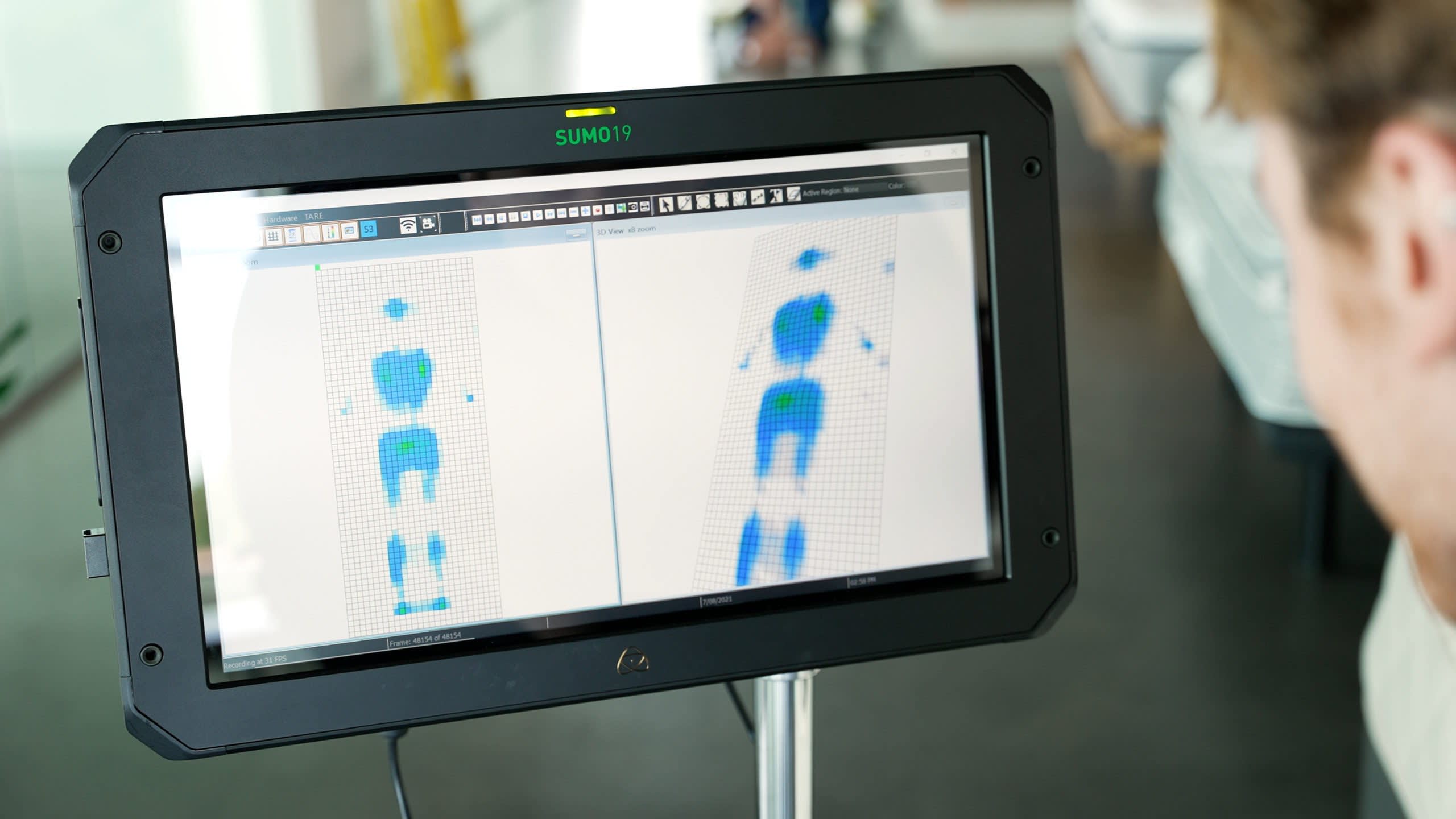
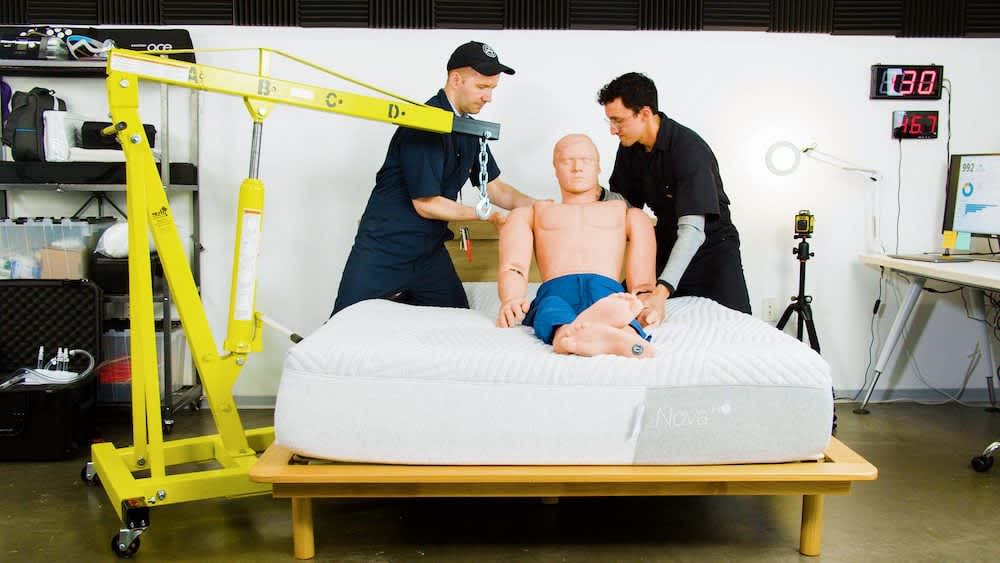
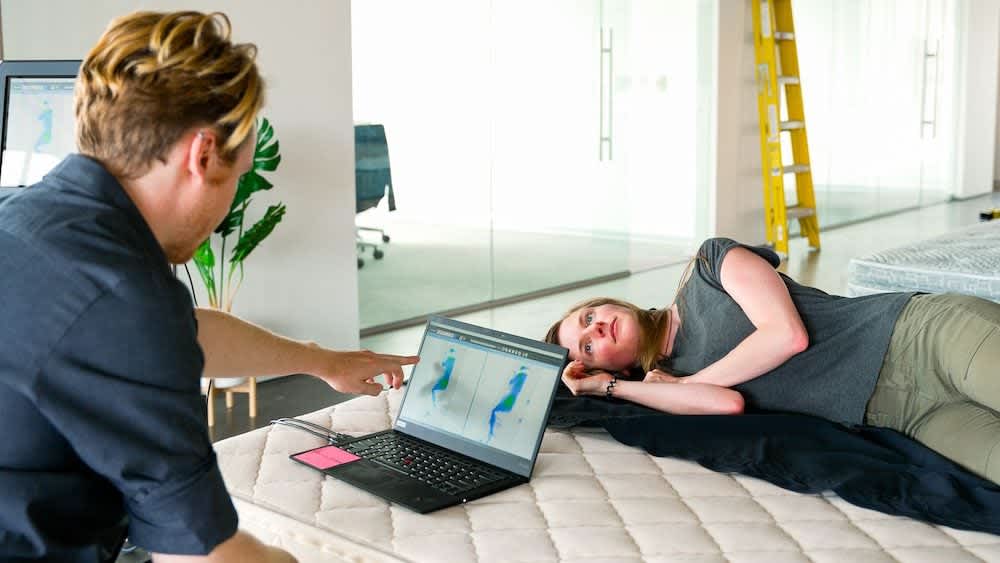
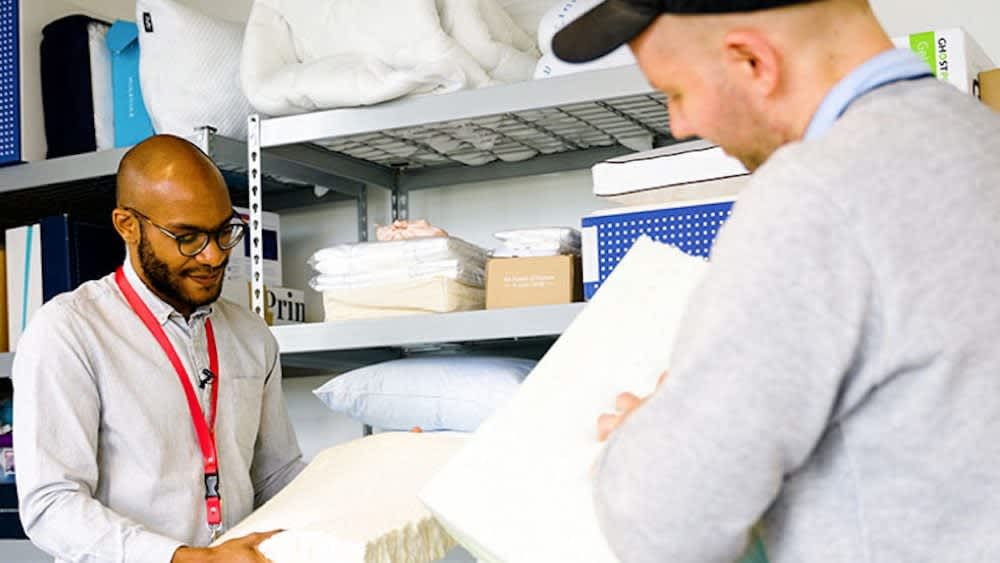
motion isolation
This criteria alludes to the amount of motion a mattress absorbs when a sleeper moves on the surface. We use two testers lying side by side to evaluate motion isolation, who each feel for transfer while the other person moves on the mattress.
temperature control
To determine how well a mattress regulates temperature, we perform temperature tests and look closely at its materials and construction. Many mattresses are designed with cooling components meant to reduce heat retention.
pressure relief
A bed with strong pressure relief excels at preventing pressure from building up in areas like the shoulders and hips. Beds with even contouring and weight distribution are top performers when it comes to pressure relief.
Off-Gassing
A mattress in a box may release unpleasant chemical odors for a short period after you’ve unboxed it. The initial smell may be strong but typically fades within 2 or 3 days.
ease of movement
This criteria reflects how easily a sleeper can move across a bed’s surface. Responsive surfaces made of latex typically perform better than foam surfaces, which can inhibit movement.
edge support
We perform sit tests along a bed’s perimeter to measure how well the edges push back against weight. Mattresses with strong edge support have minimal sagging when sleepers sit on or lie close to the perimeter.
Dive Deeper — In-Depth Mattress Guides
For more help deciding which mattress is right for your specific needs, check out the guides below.
Best Mattress by Specific Purpose
What to Consider in a Mattress for Back Pain
A mattress plays an important role in how the body is positioned throughout the night. Most people know that posture is important but only think about it in the context of standing and sitting. This can cause them to overlook the importance of having a mattress that is the proper fit based on their body shape, weight, and sleeping position.
Mattresses and Lower Back Pain
Lower back pain is by far the most common type of back pain. It affects the lumbar region, which includes the lowest five vertebrae (L1-L5) of the spine.
The lower back has more curvature and range of motion than other parts of the back, and this makes it more susceptible to injury related to movement and posture, including positioning during sleep. If a mattress offers insufficient support, the lower back may twist or bend in an unnatural way. We’ve found that if the bed is too soft or is worn out, the hips, which carry more weight, may sink deeply into the mattress and out of alignment with the lumbar area. When that or any other misaligned position is held for an extended period during the night, it can be a direct contributor to back pain.
Mattresses and Mid-Back Pain
Middle back pain is much less common than lower back pain. The middle back is generally identified as above the lumbar spine but below the rib cage.
Stiffness and aching in the mid-back can arise because of poor posture and lack of spinal support. Because of the amount of time spent in the lying position during sleep, these alignment issues can often be connected to a mattress that does not adequately support the body and cushion a person’s pressure points.
Mattresses and Upper Back Pain
Upper back pain is less common than lower back pain but occurs more frequently than middle back pain. It affects the thoracic region, which runs from the bottom of the rib cage up to the lower neck and involves the 12 vertebrae that connect to the ribs.
Pain in the upper back and shoulders can come from awkward or unsupportive body positioning. If a pillow is not the right height or if a mattress doesn’t properly accommodate the shoulders, it may place undue pressure on the anatomy of the thoracic region, heightening the risk of upper back pain.
Mattresses and Neck Pain
Neck pain can occur due to different reasons. Many people develop strains and sore spots due to less-than-optimal posture, which can be especially problematic for people who sit at a desk for their jobs. The pillow and mattress you choose are important considerations for people with neck pain. Our product tests reveal time and time again that, in order to reduce aches and pains, a pillow should provide enough support and loft to keep your neck aligned with the spine and hips.
Sleeping Position and Back Pain
Each sleeping position creates a unique set of pressure points and areas that need cushioning, and this is why our testers believe having the right mattress to suit your sleeping position is an important part of preventing and reducing back pain.
Back sleepers tend to have their most serious pressure points around the lumbar area. Our pressure tests on various mattresses have shown that if a mattress is too soft, the weight of the abdomen will cause this region to sink out of alignment with the rest of the back and hips. If the mattress is too hard, it won’t accommodate the natural curvature of the spine in the lumbar area. For this reason, a medium firm to firm mattress usually works best for back sleepers.
Side sleepers have high-impact areas where the body is the widest, notably at the shoulders and hips. A mattress needs to be contouring enough to cushion those pressure points but not so soft as to let them sink too deeply into the bed and out of line with the rest of the body. Most side sleepers on our test team get the best results from a medium to medium firm mattress.
Stomach sleepers have pronounced pressure points in the lumbar area and around the neck. If their pillow is too tall, it can put excess bend in the neck and upper back. If the mattress is soft, the pelvic area can dip too far, putting the body in a U shape that stresses the spine as well as the muscles and ligaments in the lower back. As a result, stomach sleepers on our team tend to have less back pain if they use a thin pillow and have a firm mattress. Stomach sleepers who weigh more than 230 pounds may even benefit from an extra firm mattress.
“Back and stomach sleepers may benefit from a firmer mattress, as extra support can feel more comfortable in these positions. Side sleepers may prefer a mattress that has softness. It’s also important for side sleepers to find an option that ensures the head and neck are in alignment. Whatever is the most comfortable for you to sleep with is worth the investment.”
– Sarah Silverman, Psy.D., a licensed psychologist and holistic sleep wellness consultant who treats patients in New York and Florida.
No matter what type of sleeper you are, changing your sleeping position is one way to try to get back pain relief.
If you are a back or stomach sleeper with a soft mattress and you don’t have the budget for a new bed, try switching to a side sleeping position that will give you more support from your existing mattress. Experts generally recommend that stomach sleepers try to adjust to side or back sleeping because it’s easier to get appropriate support in those positions.
Along with sleeping position, body weight is another important factor to consider when choosing your mattress. People who weigh more will sink further into a mattress, exacerbating the risks in all sleeping positions of the heavier parts of the body becoming misaligned. Sleepers of above-average body weight (over 230 pounds) typically need a firmer mattress than someone of average weight who sleeps in the same position.
Similarly, people who weigh under 130 pounds are less prone to sinking into the bed, and can sleep on a softer, more contouring mattress without the same risks of the body sagging out of alignment.
For more on the best mattress for back pain relief for different types of sleeping positions check out the video below.
Which Type of Mattress is Best for Back Pain?
A key step in choosing a mattress is deciding which mattress type is most likely to work for you. Virtually all mattresses on the market today can be broken into five types based on their construction and materials.
Within each category, you can find consistent features; however, we know there can be notable variation from one brand or model to the next. Some types allow for a greater diversity of designs, which leads to a wider variation in the expected feel and performance of any specific mattress.
Hybrid
Definition: Hybrids are constructed with an innerspring support core that is supplemented by a significant comfort system that may include layers of foam, latex, microcoils, cotton or fiber fill, down, and/or wool. The comfort layers on a hybrid are much more robust than on an innerspring mattress.
Highlight: Balanced Features. Hybrids try to capture the best of multiple bed types without suffering from their downsides. For example, we’ve found that hybrids tend to offer moderate to significant contouring that aids in pressure point relief, while their coils permit excellent ventilation, making temperature regulation a plus on most hybrid beds.
Innerspring
Definition: An innerspring mattress is composed almost entirely of metal coils. There may be a thin layer of cotton, polyester, or foam above the coils, but we generally find that this layer does not significantly change the mattress performance. Historically, innersprings were the most common mattresses, but their popularity has declined considerably as foam, latex, and hybrid models have gained steam.
Highlight: Inexpensive and Customizable. A benefit to innersprings is that they are among the most inexpensive options that you can find. One option we recommend is to use the money saved to customize the bed’s feel with a mattress topper.
Latex
Definition: Latex mattresses have an interior construction made completely with latex, which is a type of rubber. Most mattresses use natural latex from trees, but synthetic or blended latex is used occasionally. The comfort layers and support core may employ different types of formulations of latex.
Highlight: Supportive Contouring. We’ve tested numerous latex beds, and most of them have moderate contouring effects. This allows the bed to cushion the body without an excessive amount of sink.
Airbed
Definition: Airbeds feature a support core of inflatable chambers. Sleepers can use a remote or smartphone app to control a pump that can add or remove air from the chambers, adjusting firmness in real time. There may be other materials, including foam, latex, cotton, polyester, or wool, layered as a comfort system above the support core.
Highlight: Adjustable Firmness. Our test team believes the primary benefit of airbeds is their adjustability. Being able to quickly modify the firmness of the bed can be a huge plus for people with back pain because it lets them get “dialed in” depending on the nature of their pain and posture at that exact point in time.
Foam
Definition: Foam is layered to create both the support core and comfort system of an all-foam mattress. Memory foam is a popular material in foam mattresses as is polyurethane foam (polyfoam), which can be manufactured to have a range of distinct characteristics. Latex may be included among the layers, but no coils are used in a foam mattress.
Highlight: Deep Contouring. Memory foam tends to offer the highest degree of hug. This allows these mattresses to deliver proportional cushioning to the areas of the body that need it most. Side sleepers on our test team can attest that foam is especially useful for cushioning sharp impact points like shoulders and hips.
Mattress Features to Look for to Relieve Back Pain
When shopping for a mattress to help relieve back pain, some features are more important than others. With so many products and a bevy of marketing hype, it can be tough to parse out what really matters. Based on our extensive experience testing mattresses, we believe that you’re most likely to get the most satisfaction out of your purchase by focusing on certain key considerations:
- Mattress Type: The materials and design will play a huge role in the performance of a mattress. The contouring, bounce, firmness, temperature regulation, and motion isolation of a mattress will be different for each mattress type, so it is critical for shoppers to think about their priorities and choose a mattress with components that will best meet their needs.
- Zoned Support: Weight from the body is not distributed evenly; instead, certain areas tend to require more cushioning. A zoned mattress takes that into account and offers reinforced support in those areas.
- Quality Materials: We’ve found that a mattress made with excellent materials is much more likely to provide the performance, reliability, and durability that people with back pain need.
- Firmness Level: Firmness is a key driver of mattress comfort and is largely a matter of personal preference. At the same time, the right firmness level can play a big part in whether a mattress offers sufficient support, and that will depend significantly on a person’s body weight and sleeping position.
Frequently Asked Questions
We believe that the best bed for someone with back pain is one that is suited to their body type and preferred sleeping position. Back pain-friendly models are available in all mattress types, but most of our testers agree that hybrid mattresses offer the best combination of support and pressure relief.
Pocketed coils tend to allow for better spinal alignment than innerspring or foam support cores, particularly if the coils are ergonomically zoned. Meanwhile, a hybrid’s comfort system — usually made from synthetic foam or latex — provides the pressure relief and contouring required to release tension and avoid pressure points. Individual mattresses, of course, can be better or worse for back pain regardless of their construction type.
Many people believe that a firm mattress is best for back pain, but our testers have found that people with back pain should — like all sleepers — choose a mattress firmness that suits their weight and is neither too soft nor too firm. People who weigh under 130 pounds tend to require medium soft or even soft mattresses, while those who weigh above 230 pounds usually prefer medium firm or firm beds.
Despite the difference in objective firmness, the subjective feel should be quite similar thanks to the way mattresses compress beneath weight. The right mattress will feel firm enough to offer support while soft enough to prevent aches or pains. For people who are accustomed to sleeping on a mattress that is too soft, choosing a mattress with pressure relieving qualities can help them adjust to the correct firmness level.
People with lower back pain often find the most relief when sleeping on their side with their knees partially bent. Placing a pillow between your knees can also make this position more comfortable so long as the pillow is the right size to promote correct spinal and hip alignment. Pillows placed beneath the knees or at the small of the back can also help people who prefer to sleep on their back. Stomach sleepers on our team find relief by using a thin pillow for their head and a more supportive pillow beneath their stomach and hips.
You may have to experiment with different pillows before finding what works for you, as the wrong size or shape of pillow can sometimes worsen the situation. For many people, particularly those who sleep on their stomach, switching sleeping positions offers better results than any combination of pillows.
If you suffer from upper back pain, it is best to sleep on your side or back since sleeping on your stomach causes significant tension in the shoulders and neck. Side sleepers may also experience upper back and shoulder pain if their mattress has inadequate pressure relief, since the position can cramp these areas and create pressure points and tension where your shoulder presses into the bed.
Regardless of your sleep position, we’ve found that choosing the best pillow is also an essential factor in relieving upper back and shoulder pain.
A major benefit of a topper is that you can take advantage of a new comfort system that fits your needs. This may include a change in the firmness and/or the contouring to cushion your pressure points. For people with back pain, the difference can be notable and serve as a meaningful step toward better sleep.
At the same time, it’s important to remember that any topper comes with potential downsides. Every material has pros and cons, and those will be reflected in a topper. Our sleep lab has tested a fair amount of toppers, and we’ve noticed that most sleepers above 130 pounds need a topper that is at least 2 inches thick, and higher-quality versions can cost a few hundred dollars.

Still have questions?
Our product experts have extensive experience testing just about every sleep product on the market.
Send an email to [email protected] with your questions and we’ll help you find exactly what you’re looking for.





